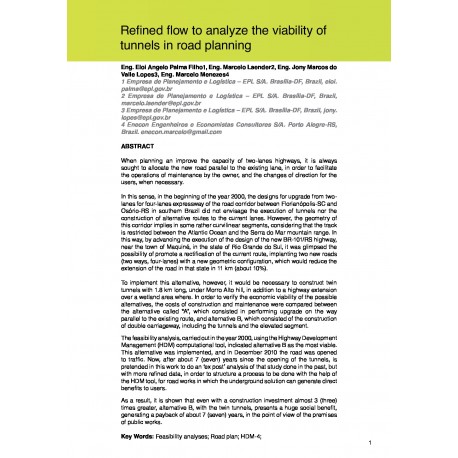Cart
0
0
No document
0,00 €
Total
Document successfully added to your shopping cart
Quantity
Total
There are 0 items in your cart.
There is 1 item in your cart.
Total documents
Total shipping
To be determined
Total
Search & filter
Search for a publication
Search & filter
Viewed documents

Refined flow to analyze the viability of tunnels in road planning
2423_refined_flow_to_analyze_the
E. A. Palma Filho / M. Laender / J. M. do Valle Lopes / M. Menezes
When planning an improve the capacity of two-lanes highways, it is always sought to allocate the new road parallel to the existing lane, in order to facilitate the operations of maintenance by the owner, and the changes of direction for the users, when necessary. In this sense, in the beginning of the year 2000, the designs for upgrade from twolanes for four-lanes expressway of the road corridor between Florianópolis-SC and Osório-RS in southern Brazil did not envisage the execution of tunnels nor the construction of alternative routes to the current lanes. However, the geometry of this corridor implies in some rather curvilinear segments, considering that the track is restricted between the Atlantic Ocean and the Serra do Mar mountain range. In this way, by advancing the execution of the design of the new BR-101/RS highway, near the town of Maquiné, in the state of Rio Grande do Sul, it was glimpsed the possibility of promote a rectification of the current route, implanting two new roads (two ways, four-lanes) with a new geometric configuration, which would reduce the extension of the road in that state in 11 km (about 10%). To implement this alternative, however, it would be necessary to construct twin tunnels with 1.8 km long, under Morro Alto hill, in addition to a highway extension over a wetland area where. In order to verify the economic viability of the possible alternatives, the costs of construction and maintenance were compared between the alternative called “A”, which consisted in performing upgrade on the way parallel to the existing route, and alternative B, which consisted of the construction of double carriageway, including the tunnels and the elevated segment. The feasibility analysis, carried out in the year 2000, using the Highway Development Management (HDM) computational tool, indicated alternative B as the most viable. This alternative was implemented, and in December 2010 the road was opened to traffic. Now, after about 7 (seven) years since the opening of the tunnels, is pretended in this work to do an ‘ex post’ analysis of that study done in the past, but with more refined data, in order to structure a process to be done with the help of the HDM tool, for road works in which the underground solution can generate direct benefits to users. As a result, it is shown that even with a construction investment almost 3 (three) times greater, alternative B, with the twin tunnels, presents a huge social benefit, generating a payback of about 7 (seven) years, in the point of view of the premises of public works.


